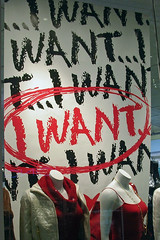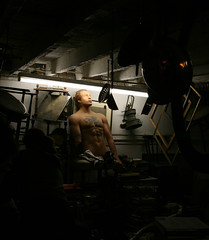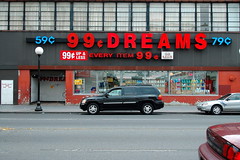 Low-functionality watches: How the value of a watch becomes detached from its role as a timekeeper.
Low-functionality watches: How the value of a watch becomes detached from its role as a timekeeper.
The chief function of a watch, you might assume, is to tell the time, accurately. But watches can do other things too. Some years ago, for instance, there was a trend toward watches with calculators built into them, although that didn’t last. Also there’s the aesthetic factor. The look of a watch might sound more like a matter of form, but style has its functions, too.
The watch is an interesting product category through which to examine the function of style…
Continue reading at the NYT Magazine site.
Regular Murketing readers will recognize that this is theme I’ve pursued a bit here, in previous posts here, here, here, here, here, and here.
The caption: “Rampant Consumerism is the product featured in this window display from the store Wet Seal, at the Santa Rosa Plaza. In case you don’t have the proper mindset for mall shopping, Wet Seal has a helpful hint.”
Posted Under:
Flickr Artifacts by Rob Walker on October 28, 2007
Comments Off on Flickr Interlude
See also the enjoyable set Trash.
The other day I got an email informing me about this web site: Catalog Choice. It is a “sponsored project” of The Ecology Center.
The idea is that you can use the site to opt off the mailing lists of various catalog-sending retailers.
I’ve finally gotten around to registering (I don’t exactly know why that’s necessary, but maybe there’s a good reason) and have started entering catalog info. You kind of need each unwanted catalog at hand when you’re doing this, because part of the process is entering the customer number from the label. They say it takes 10 weeks or so for each catalog to stop. And they don’t have every catalog in the system yet, but you can make requests.
So anyway I’ll let you know what happens, but if anybody else out there is interested in stopping the rather wasteful flow of paper … now you know.
Yes, as a matter of fact, the Wall Street Journal’s front-page story today on Nike “tapping influencers” is several years late. But it’s still worth reading. (And at least they got it. While I’ve mentioned things like Futura and Mr. Cartoon, to name two examples in the piece, doing Nike stuff in the past, my own attempts to get an interview with Mark Parker a couple of years ago were totally stonewalled. Oh well.) In particular I liked this bit:
Not everyone is so anxious to see Nike roll into new turf. Recently, designer Steve “Birdo” Guisinger, owner of a small but influential Santa Cruz, Calif., retailer called Consolidated Skateboards, painted three wheel-less skateboard “decks” with images that lampooned Nike’s attempts to craft a more street-smart image. The board depicting Mr. Parker shows him in a T-shirt with flame tattoos running up one arm and a chauffeured white limousine waiting behind him.
Mr. Guisinger says the parody was meant to “raise awareness,” about the “behind the scenes jockeying that was going on with [Nike’s] attempt to enter the skateboard industry.”
Nike’s response was characteristically in-your-face. Global design head Sandy Bodecker — shown on one of the boards with a sales projection chart and a brown nose — purchased them on eBay and recently displayed them proudly in a prototype for a Nike retail concept store. “I personally was very pleased to be in such august company” he says.
Heh.
There’s also some material about Os Gêmeos. I was sort of pitched about Os Gêmeos at one point, but my interest was entirely in the role that Nike played in basically establishing them in the U.S. scene, and I was told that nobody involved was really interested in talking to me about that angle. But you get a decent sense of it here — Parker introduced them to the Deitch gallery, etc. So, again, the broad theme of the piece isn’t going to surprise anyone who’s been paying attention, but they got some facts.
Seriously, how can something be both so popular, and so consistently, relentlessly, hideous, at the same time?
I’ve read a million stories and experts talking about how more of us know more about good design than ever and we crave it and we’ll pay for it etc. But face it: MySpace remains more popular than almost any good design product you can name, and it’s uglier than the 1970s.
So has the country’s collective design taste improved — or not?
UPDATE (December 8): In addition to the comments below, which are now closed, see this follow-up post and comments.
Business Week had a story recently about Kenneth Cole’s brother, Neil, who is now running a company called Iconix. The business model of Iconix is that it buys fashion brands — but just the brand, not the company. Through a licensing arrangement, it sells others the right to actually design and manufacture the apparel, in exchange for a “guaranteed royalty of 4% to 10%.” (I’m assuming that’s a percent of gross, not net, but if the article says for certain, I missed it.)
I was interested to see that its most recent deal is with Wal-Mart, which will be “the exclusive U.S. licensee of the surfwear pioneer Op brand.” I used to wear Op when I was in junior high or so, and about two years ago I think I noticed that a boutique I like in Manhattan, Gerry’s (which tends to stock brands like Ted Baker and Modern Amusement), was carrying Op stuff, which I hadn’t seen in many years. I remember chatting with clerk about it, and he claimed it was selling well. Since then I’ve seen some Op ads in some hipster lifestyle magazines, and even briefly considered doing a Consumed on it, but never did.
Other Iconix brands include Joe Boxer and Mossimo (which I gather are exclusively sold in Sears/K Mart and Target, respectively), and, I was surprised to learn, Roca Wear.
The article spends more time on Cole’s up and down career than on details of this business, but supposedly it’s doing well. (Although some of the downs in his career kind of give me pause.)
What’s interesting about licensing businesses in general is that despite the assorted chatter about brand-skeptical consumers, licensing can be very lucrative precisely because of brands’ power to transform commodities. It’s particularly interesting when it happens with brands that have fallen on hard times, but are still familiar. With the right cost structure and the right marketing, they can build on that familiarity. (This is the subject of an article I’m working on now, actually, so more on that in the future.)
Op will be an interesting one to watch, and I wish I knew more of the back story. Was it totally dead for a while? Who was behind the Op stuff that was popping up in Gerry’s, of all places? From whom did Iconix acquire the marks, and when? Who will be doing the designs? Lots of people will recognize the brand when they see it, but younger people probably won’t. Who will the consumer be? Etc. Like I said, should be an interesting one to watch.
UPDATE: An incoming link leads me back to this bit on an interesting blog called Legal Fixation: “Although there are numerous OP and OCEAN PACIFIC trademark registrations, the assignment history of this OCEAN PACIFIC registration gives some good clues as to the transactions.”
Posted Under:
Flickr Artifacts by Rob Walker on October 23, 2007
Comments Off on Flickr Interlude
I noticed this stuff on the shelf at my local Kroger yesterday. It raised a few questions for me. I don’t immediately associate crayons with something I’m supposed to swallow.
It seems particularly odd to brand an “all natural” fruit juice this way. What’s all-natural about crayons? I don’t have the slightest idea how they’re made (Wikipedia says the key ingredient is paraffin wax, “a petroleum product,” and maybe that’s true) but I’m pretty sure it’s a synthetic process that happens in a factory, and they’re not plucked fresh from a field.
Obviously, though, they’re going after kids with this, and there seems to be a feeling out there that a healthy drink for kids could be a big hit.
Apparently Crayons has no direct connection to Crayola, despite the fairly indisputable attempt to suggest that connection. A Seattle Times story on the company’s site says the founder “bought the Crayons trademark for use with food beverages” in 2003. He got it “from someone who had been tinkering with using it with juices on the East Coast.” But it’s “not the same as Crayola.” I guess maybe “crayon” is a generic term that pre-dates Crayola. (Side note: Refreshing my memory about Crayola packaging led me to a collector site with some cool old designs).
Anyway, the Seattle Times article says this beverage is in 2,000 supermarkets nationwide, but there was no sales data.
What this seems to be is a kind of case study in the power of recognizability and familiarity. I’m sure that the stuff caught my eye on the shelf because I recognized the word crayon. In my case, I wasn’t tempted to see what crayons taste like, or whatever, but I guess it does “engage” the shopper on some level. Maybe others — again, children seem to be the main target — will be curious enough to try a can, and if it’s good they’ll come back for more.
One would assume that this strategy has limits, and that the recognizable word has to be not only recognizable, but relevant to the category at hand. But maybe this simply stretches the definition of “relevance,” in that “crayon” is sort of a fun, happy, feel-good word. (Compared to, say, “nylon.”) Interesting experiment.
Bonus link: Metafilter “All you ever needed to know about crayons.”
Freshness recently offered a look at the latest from Upper Playground, including the T above. I’m not sure what to think about it.
Posted Under:
Brand Underground by Rob Walker on October 22, 2007
Comments Off on Ghetto Grocery T: Funny?
Poor Don Draper! Fresh off a wildly successful presentation that landed Kodak as a client — leaving the execs slack-jawed in amazement at his spiel about their slide wheel as a “carousel” that reveals all that is truly important to us in life — Don goes home to find his family has left for Thanksgiving vacation without him. For a moment, he apparently envisioned arriving just in time to make up for his previously dickish behavior by joining them for a journey to the in-laws’ … but no. They’re gone, and all he can do is sit alone on the stairs, perhaps reflecting on the fact that his bullshit has gotten so good that evidently even he believes it. Or he did. For a minute. Please continue…
Posted Under:
Mad Men musings by Rob Walker on October 22, 2007
Comments Off on Mad Men Musings: Bad memories
 Print Gocco: How the end of a product turned into a publicity event — and, maybe, a new beginning.
Print Gocco: How the end of a product turned into a publicity event — and, maybe, a new beginning.
… Print Gocco is both better known and somehow cooler than it has ever been here. And this is almost certainly because in late 2005, the Riso Kagaku Corporation, now an international and largely digital business, announced that Gocco was dead…
Read the column at the NYT Magazine site.
Additional Links: Save Gocco! … Shu-Ju Wang’s site … Blissen … Wurst Gallery Gocco show … Paper Source … Gocco at Poppytalk
New Murketing column in the November issue of Fast Company:
In the recent book Gut Feelings: The Intelligence of the Unconscious, psychologist Gerd Gigerenzer makes the case for intuition. Curiously, many assessments of the book took for granted that his arguments, familiar to readers of Malcolm Gladwell’s Blink, cut against conventional wisdom — that trusting intuition is, in fact, counterintuitive. As one friendly interviewer, casting Gigerenzer as a contrarian, put it: “In modern society, gut thinking has a bad reputation.”
Oh, really? …
Continue reading at Fast Company’s site.
Portfolio has a big piece about Nigo. I skimmed it quickly, and I have to say that the Complex blog found the one interesting quote, from Hiroshi Fujiwara:
Fujiwara, who is still revered in Tokyo as perhaps the one man who can launch a trend, is even more dismissive of Nigo. “I just wonder how he feels when he sees ugly people wearing his clothes. If you go to the countryside in America and people are wearing Bathing Ape, that’s not very cool.” Fujiwara, now a consultant for Nike and Levi’s, shrugs. “I thought he was more like us, but he changed.”
Hm. Well, I hope his clients Nike and Levi’s take heed, and prevent “ugly people” from buying their products.
 Low-functionality watches: How the value of a watch becomes detached from its role as a timekeeper.
Low-functionality watches: How the value of a watch becomes detached from its role as a timekeeper.



 "
"




















 Kim Fellner's book
Kim Fellner's book  A
A